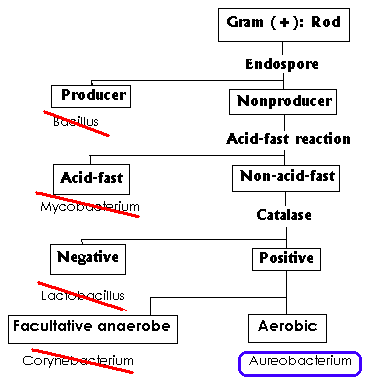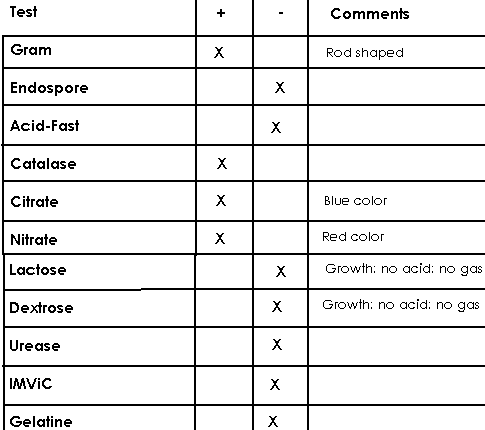

Dave Fonseca - Aureobacterium
This isolate was obtained from a slide that was near the top of the lit column, just below the surface of the water. The sample was streak plated until a single colony was able to be isolated. It was during this time that I discovered accidentally that this isolate grows well at 25 degrees Celsius in my drawer and it grows poorly at 37 degrees Celsius in the incubator. To begin the tests to identify the microorganism I started with a Gram stain to determine its morphology and Gram stain ability. The isolate was found to be a Gram positive (+) rod. The next test I performed was an endospore test, the isolate did not produce spores. I followed with an acid-fast test and the isolate was acid-fast negative (-) thus ruling out Mycobacterium. I now knew I was working with a bacteria. The next test I performed was a catalase test, which was positive (+). I then did a stab inoculation test and found the bacteria to be strictly aerobic. The lab manual identified microorganisms with these traits as Corynebacterium but I decided to do further tests to be sure. After consulting Bergey’s Manual I decided to redo the Gram stain to look at the morphology. I found the rods to have an irregular shape, they were not symmetrical. I also performed nitrate, citrate, urease, IMViC, gelatin, dextrose, and lactose tests. Using the flow chart tests to narrow down my choices, using the latter tests to rule out any other bacteria, the fact that it grew well at 25 degrees Celsius and not 37 degrees, and the colony had a yellow color I was able to identify the bacteria as of the genera Aureobacterium. Bergey’s Manual identifies Aureobacterium as an irregular shaped, Gram positive rod that is strictly aerobic, catalase positive, produces little acid in dextrose broth, grows well at about 25 degrees Celsius and does not grow well at about 37 degrees Celsius, and the colony has a yellow pigment. Bergey’s Manual also identified its habitat as water, soil, and sewage, which would make sense since the mud and water samples were obtained need the waste-water treatment plant.

